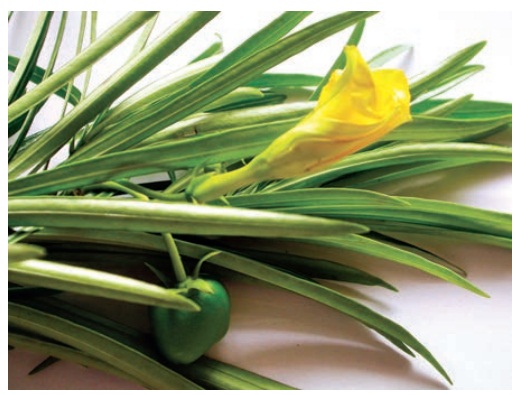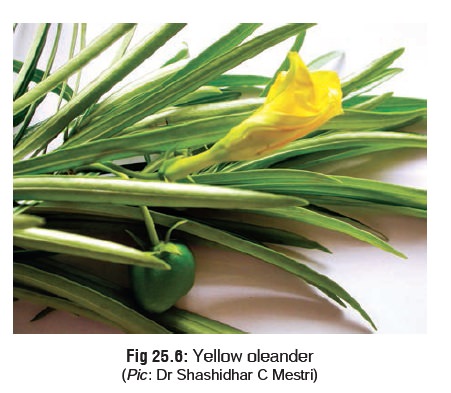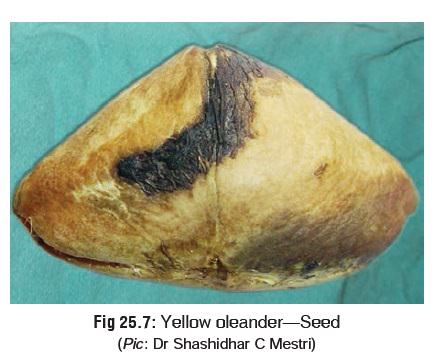Chapter: Modern Medical Toxicology: Cardiovascular Poisons: Cardiotoxic Plants
Yellow Oleander - Cardiotoxic Plant

Yellow Oleander
Other Common Names
·
Bastard oleander, Exile oleander,
Be-still tree, Lucky nut, Tiger apple.
Botanical Name
·
Thevetia
peruviana, T.neriifolia, Cerbera thevetia.
Physical Appearance
It is an ornamental shrub (that grows to about 30 feet
height) belonging to family Apocynaceae with longish (about 15 cm long) leaves
yielding a milky sap, and yellowish funnel-shaped flowers (Fig 25.6 ). The leaves are pointed, with dark green upper surface,
and lighter green undersides. The edges are often rolled. Fruit is diamond
shaped or clam shaped, and has 2 to 4 seeds in its stony inner section. It is
about ½ inch in size, greenish at first, and turning yellow when ripe, and may
even appear blackish in the later stages. The kernel (seed) is very toxic (Fig 25.7). All parts of the plant
contain a milky juice or sap.


Toxic Part
All parts, particularly seeds and root. Yellow oleander
plant parts are generally more toxic than Nerium
oleander.
Toxic Principles
·
Cerberin
·
Nerifolin
·
Peruvoside
·
Ruvoside
·
Thevetin A and B
· In decreasing order of toxicity, the most toxic glycosides in yellow oleander are: peruvoside, ruvoside, thevetin A, nerifolin, cerberin, and thevetin B.
Uses
■■ Like common
oleander, yellow oleander is also used in traditional Indian medicine for the
treatment of various ailments.
■■ Bark extracts
containing cardenolides have been investigated as cytotoxic agents in cancer
research.
Usual Fatal Dose
· About 8 to 10 seeds.
· About 15 to 20 grams of root.
The
rest of the information is essentially the same as that for common oleander (vide supra), though toxicity is likely
to be more severe.
The
commonest manifestations associated with yellow oleander poisoning include
bradycardia with AV block, hypo-tension, lethargy, dizziness, and GI distress.
Convulsions, electrolyte disturbances, hypertension, and coma have also been
reported. Mydriasis may occur. Numbness and burning sensation of the mouth may
develop.
The
sap of yellow oleander tree may cause blistering or dermatitis on contact.
Subendocardial
and perivascular haemorrhage with focal myocardial oedema have been found
during autopsies of some of the patients who died.
Cardiac
glycosides of this plant are best identified by radioimmunoassay.
As
far as specific treatment is concerned, it has been shown that anti-digoxin Fab
fragments are effective in the management of yellow oleander-induced arrhythmias.
They rapidly restore sinus rhythm, and revert bradycardia and hyperkalaemia
back to normalcy. Digoxin Fab fragments are indicated if the potas-sium
concentration exceeds the upper limit of the normal range (5 mEq/L), in
association with other severe symptoms. Even if the exact cause is uncertain as
to whether yellow oleander is the culprit in a given case, some investigators
recommend the empiric administration of 10 vials of digoxin-specific Fab.
However, serum potassium can drop steeply, and must be monitored frequently for
several hours post-administration. This is especially likely to occur if Fab
fragments have been given along with glucose, insulin, and bicarbonate. The
latter combination therapy (glucose, insulin, and bicarbonate) must be tried only
if Fab fragments are not available.
Atropine
is useful in the management of bradycardia, and varying degrees of heart block.
Lignocaine is useful in the manage-ment of ventricular tachy-arrhythmias, PVCs,
and bigeminy.
Certain
steroid compounds such as spironolactone and pregnenolone-16alpha-carbonitrile
have been shown to decrease glycoside toxicity by increasing biliary excretion.
Although not yet tried in humans, these agents could be tried as a treatment
modality.
Related Topics